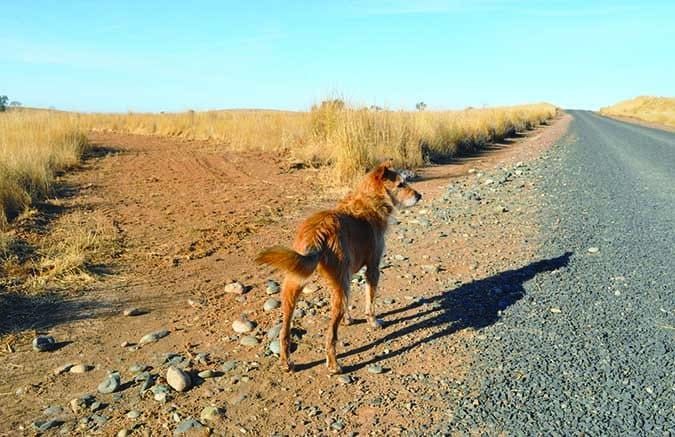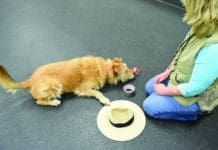Some 30 years ago, Karen Pryor wrote a small volume intended to be a self-help book for humans. That book turned the dog training world upside down. Don’t Shoot the Dog introduced the general public to the principles of operant conditioning and emphasized the benefits of positive reinforcement over punishment, with the goal of improving humans’ relationships with each other: husbands and wives, parents and children, employers and employees, etc. The book didn’t make much of a splash in the self-help world. But the fortuitous inclusion of the word “dog” in the title captured the attention of dog trainers, who, led by early positive training notables such as Dr. Ian Dunbar and Jean Donaldson, launched a positive reinforcement revolution in the world of dog training.
Thanks to the pioneers in the development of effective, force-free dog training techniques, there are now thousands of trainers (including me) who use, teach, and promote force-free training. In the past few decades, we’ve learned the value of creating relationships with dogs based on voluntary cooperation, built on a foundation of mutual trust and respect.
We learned about the “four quadrants of operant conditioning,” and realized that the tools many of us had successfully used in the past, such as choke chains and prong collars, and verbal and physical punishment, worked because they suppressed behavior. They taught the dog that if he did the wrong thing, we would hurt or intimidate him.
We learned to ask questions. Not just, “Does this work?” but “Why does this work?’ and the very important “Is this something I am willing to do to my dog?”
We learned that there was an entire body of science behind dog training and behavior. We eagerly embraced the science, and learned about behavior analysis, unconditioned responses, classical conditioning, and much more.
The more we learned, the more we committed to our position that, while old-fashioned punishment-based methods may work, there is no need to use them, and no ethical justification to do so. We became operant conditioning junkies. We thought we had it all figured out.
Then the world shifted again.
Cognitive scientists turned their attention to dogs, and confirmed what we had suspected all along: that canine behavior is far more complex than what can be explained by Skinner boxes and Pavlovian responses. Our canine companions not only share a wide range of emotions comparable to our own, but also, they are capable of grasping and applying complex concepts, functioning on a higher cognitive level than we had previously been encouraged to believe. While positive reinforcement-based trainers had long come to value the role of “relationship” in training, to a blossoming new generation of trainers, “relationship” doesn’t just have a role; instead, training is relationship.
Positive reinforcement-based trainers have acknowledged the importance of relationship, in part, just by altering our vocabulary. Because they are a reflection of our internal processing, and because they influence our associations, words matter. Many of us now say “Cue” (a signal that indicates an opportunity to perform a behavior to gain a reinforcer) instead of “Command” (do this behavior or else!). We call our training classes “good manners” instead of “obedience.” We “ask” or “help” our dog do a behavior rather than “make” him do it. We recognize that, as the supposedly more intelligent species, it’s our job to get our dogs to demonstrate that they happily and eagerly want to do what we ask of them.
Some professionals are going one step further, calling themselves “teachers” rather than “trainers,” and suggesting that we are “educating” dogs in a broader, cognitive sense rather than just “training” them to do a specific set of rote behaviors. It’s a compelling position.
Our Dogs’ Choices and Empowerment
One would expect that the rise of force-free training methods and the increased awareness of and respect for dogs as sentient creatures would make life easier for them. We should expect to see a corresponding rise in the number of calm, stable, well-adjusted dogs who are happily integrated into lifelong loving homes. But many training and behavior professionals note with alarm the large number of dogs in today’s world who seem to have significant issues with stress and anxiety, with high levels of arousal and low impulse control.
It’s quite possible this is a function of societal change. There was a time not so very long ago when life was pretty casual for our family dogs. They ran loose in the neighborhood day and night; ate, slept, played, and eliminated when they chose; and many had jobs that fulfilled their genetic impulses to herd some sheep or cows, or retrieve game felled by a hunter’s gun.
In contrast, life today is strictly regimented for many of our canine companions; many live in social isolation, and when they do get out, their activities are on a tight schedule. Owner expectations and demands are high. Dogs are told what to do from the moment they are allowed to get up in the morning until they are put to bed at night, including when and where they are allowed to poop and pee. Some of today’s dogs never get to run off-leash or socialize freely on a regular basis with other dogs. During any free time they may have, they are expected to just lie around and be “well behaved” (by human standards, not canine ones!). They have virtually no control over what happens in their world. Some trainers suggest this strict regimentation is a significant contributor to the stress and arousal levels of today’s family dog. Imagine how stressed you might be if your life was as tightly controlled by someone else.
Canine Empowerment Pioneer
The word “choice” started cropping up in positive training circles well over a decade ago, in no small part thanks to Susan G. Friedman, Ph.D., who was a faculty member in the Psychology department at Utah State University from 1995 to 2014. Today, Dr. Friedman is a frequent presenter at animal behavior and training conferences, always promoting the use of Applied Behavior Analysis – the technology of behavior change, developed originally for human behavior applications – for working with animals of every species.
Dr. Friedman began her career in psychology 40 years ago by working with adolescents with severe behavior problems at a residential treatment facility. After earning a Ph.D. in special education, she worked for a number of years in human education settings. She was drawn into the study of animal behavior after obtaining pet parrots for her young daughters.
“When I read the lay literature for how to care for and interact with the birds, I was horrified at the density of the cultural fog about how behavior works,” Dr. Friedman says. At the time, the field of parrot training was even more densely populated with punishment-based methods than dog training, and most of the advice that could be found was focused on getting rid of problematic (mostly aggressive) parrot behavior.
In Applied Behavior Analysis (ABA), the goal is to develop procedures that will produce objectively measurable changes in behavior. In humans, the work might be aimed at increasing the amount of time that a hyperactive child will focus on homework, or increasing the number and quality of personal self-care skills (brushing teeth, bathing) that an autistic child can be expected to perform. Given her experience with using ABA to help humans increase the incidence of their socially acceptable or personally beneficial behaviors, Dr. Friedman immediately saw that the same principles could be used to help animals change their behavior, too.
“I started writing about the science of behavior change and its basic focus: that behavior is always conditional. To change behavior we need to change conditions – not the animal! – by making the right behavior easier and more reinforcing. The wrong question is to ask how to stop problem behavior. The right question is, ‘What do you want the learner to do instead?’ ”
Dr. Friedman began writing for and presenting information to animal training audiences, explaining the benefits and strengths of using ABA for teaching children with severe behavior disorders, and suggesting that the same approach can be taken with animals of any species.
One of the most basic standards for professional ABA educators is to use the most positive, least intrusive procedures that are effective for teaching new behaviors. Dr. Friedman explains that this standard is upheld in public federal laws that protect children, as well as in the Guidelines for Responsible Conduct for Behavior Analysts. She proposes,
“Surely a similar intervention hierarchy, both ethical and feasible to implement, would be in the best interest of companion animals, their caregivers, and the professionals working with them to solve behavior problems,” she says. “By selecting the least intrusive, effective procedures (i.e., positive reinforcement-based and empowering) we increase the humaneness of our interventions without compromising our learning objectives.”
Today, Dr. Friedman maintains a busy schedule, presenting lectures and behavior workshops to all sorts of animal behavior and training professionals and enthusiasts. She’s a faculty member at Karen Pryor’s Clicker Expo and her online course, “Living and Learning with Animals for Behavior Professionals,” has provided even wider dissemination of effective, humane behavior change practices to students in more than 30 countries.
“The power to control one’s own outcomes is essential to behavioral health,” Dr. Friedman frequently tells her audiences, using examples from many captive species of animals, from marine mammals in “sea parks” to parakeets in cages (and, yes, including the dogs in our homes). “Research demonstrates that to the greatest extent possible, animals should be empowered to use their behavior to control significant events in their lives. When a lack of control becomes a lifestyle, it may result in aberrant behaviors.”
I believe that Dr. Friedman’s thesis explains many cases of canine separation anxiety, aggression, and other behaviors that indicate our dogs’ unhappiness and cause problems for dog owners. Perhaps we can help our dogs be emotionally healthier by finding ways to give them more choices in their world.
Shaping Our Dogs to Make Choices
One way we can incorporate more choice and empowerment into our dog’s daily lives is through shaping and other positive teaching techniques, where the handler sets up problems for the dog to solve.
In shaping exercises, the dog must figure out what behavior to offer in order to elicit a treat from his handler. It might be a simple behavior such as a “sit,” or it might be a complex cognitive challenge like “match to sample,” in which the dog indicates a color, shape, or object that matches the “sample” provided to him. When the dog solves the problem and offers the behavior that earns him a reinforcement, you might hear his teacher/trainer enthusiastically praise with “Good choice!” Lots of behavior choices happen in the everyday lessons of any force-free program.
But canine teachers who promote choice and empowerment have a much grander vision than basic problem-solving options. Here are some other ways in which dogs are being offered choices so they have more control in their lives, with the goal of increasing their behavioral health:
Do You Want to Work?
Some trainers now ask their dog some version of this question before embarking on any training exercise. If the dog moves agreeably or enthusiastically forward to the task, the activity continues. If the dog indicates any reluctance to engage, the activity stops, or the trainer initiates a different activity that the dog might be more enthusiastic about participating in.
The Bucket Game
London-based trainer Chirag Patel developed a protocol he calls “The Bucket Game,” in which the dog has the opportunity to indicate his choice to proceed with a husbandry procedure – or not.

Patel, who has a Bachelor of Science (Hons) degree in Veterinary Sciences from the Royal Veterinary College in London as well as a post graduate certificate at the University of Lincoln in Clinical Animal Behavior (and has a Kelpie!), presented the game to the Pet Professional Guild membership at its first conference in November 2015, and its use is spreading like wildfire. A trainer demonstrated the procedure at a recent Peaceable Paws Behavior Modification Academy. I am now a fan, and will be sharing it with many of my future clients.
In the Bucket Game, the dog is reinforced for focusing attention on the bucket (or cup, or any other small item used as a target), and the handler initiates the beginning steps of the husbandry task – perhaps touching the dog’s ears in preparation for ear cleaning. If the dog takes his attention away from the bucket, the task stops – as does the reinforcement! If the dog stays focused on the bucket (or returns his gaze to the bucket), the task (and the reinforcement) is continued. The dog learns that he controls the procedure, and as a result becomes less stressed about it, eventually choosing to continue the procedure by gazing at the bucket.
A Facebook page that has been created by Domesticated Manners for the Bucket Game describes the game as an activity that empowers the dog to indicate when she is ready to start, when she may want to take a break, when she wants to stop, and when she wants her handler to slow down. “This game was initially designed to teach essential husbandry behaviors, (those that allow your dog to actively participate in her daily and veterinary care). But you will soon learn how this game can be integrated into your every day training to help reduce barking, increase confidence, and enhance your overall relationship.”
Which Way?
Next time you take your dog for a walk, how about letting him choose the way? When you get to the end of your driveway, let him decide whether to turn left or right. If the path divides in the woods, at least sometimes follow his lead instead of always telling him which way to go. Let it be his walk.
You Pick!
If your dog isn’t accustomed to making choices with you, you can teach him to understand the choice concept with this very simple “You Pick” exercise:
1. Hold a high-value treat in one hand, and a lower-value treat in the other.
2. Show both treats to your dog in your open hands. He can sniff, but don’t allow him to eat them.
3. Close your fists, say “You Pick!” and offer both to your dog, palms up, about 6 inches apart.
4. When he “picks” one hand by sniffing it first, open your fist and let him eat that treat.
5. Repeat, using various value treats, making sure the higher value treat is not always in the same hand.
6. When your dog indicates that he understands the game by his prompt eagerness to pick a hand, generalize it by holding two of his toys and letting him pick one. (Then play with him with that toy as the reinforcer for his choice.)
7. Generalize even further by looking for opportunities to ask him to pick – which way on the hike, which food bowl, perhaps even which collar and leash he’d like to wear. Start offering him verbal choices – “Up on the sofa, or on the floor? You pick!” “Inside or outside? You pick!”
What Else?
So – where do we go with all this? All the way, with Jennifer Arnold’s Bond-Based approach (see “A Bond-Based Approach to Dog Training“), where actually teaching your dog to do specific behaviors becomes secondary to developing your relationship with him? Or is there, perhaps, a middle ground, where we are much more sensitive to the role relationships plays in our lives with our dogs, while still using positive-based training methods to help them learn the behaviors we need them know in order to live happily with humans?
We’d love to hear your thoughts. What do you think of the idea of giving your dog more choice and empowerment in his life? What opportunities can you identify in your life with your dog where you might be able to offer him more choices? Do you have examples you’d like to share of choice experiences you’ve had with your dog? As much as it stretches our brains, we’re excited about this step forward in the world of dog training and behavior. Are you?





